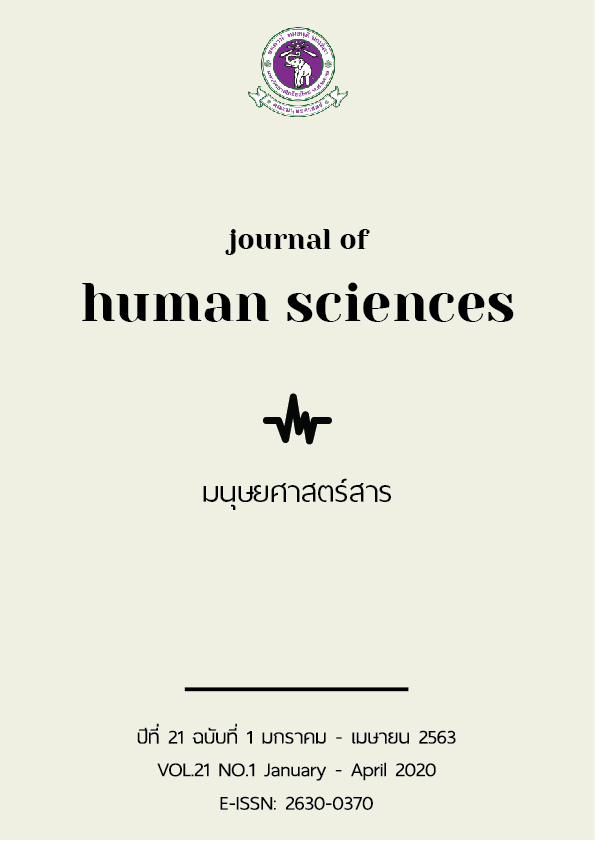กลวิธีการแปลชื่อละครและซีรีส์ไทยเป็นภาษาจีน Strategies and Analysis
Main Article Content
บทคัดย่อ
บทความนี้มีวัตถุประสงค์เพื่อวิเคราะห์กลวิธีการแปลชื่อละครหรือซีรีส์หลังข่าวของไทยเป็นภาษาจีน ซึ่งทั้งหมดเป็นละครหรือซีรีส์ที่ได้รับการจัดทำคำบรรยายใต้ภาพ ถูกตั้งชื่อเป็นภาษาจีนและได้รับการเผยแพร่บนเว็บไซต์ที่ให้บริการวีดีโอออนไลน์ในประเทศจีนจำนวน 7 แห่ง รวม 90 ชื่อเรื่อง(ภาษาจีน) โดยนำชื่อละครหรือซีรีส์ดังกล่าวมาทำการวิเคราะห์แยกประเภท โดยอาศัยแนวคิดของ Newmark (2001) ผู้เชี่ยวชาญด้านการแปลและมีการศึกษาเพิ่มเติมจากงานวิจัยกลวิธีการตั้งชื่อภาพยนตร์ไทยเป็นภาษาจีน ของ Pinpongsab (2018) โดยผลการวิเคราะห์พบว่าสามารถแบ่งรูปแบบการแปลได้เป็นสองกลุ่มหลัก กลุ่มที่ได้รับความนิยมมากที่สุดคือ การแปลแบบเน้นที่ความเข้าใจของผู้ชมละครหรือซีรีส์ ไม่เน้นการรักษาคำตามต้นฉบับ ร้อยละ 55.56 และกลุ่มที่ได้รับความนิยมรองลงมาคือการแปลแบบเน้นที่การรักษาชื่อเรื่องเดิมตามต้นฉบับ ร้อยละ 44.44 และสามารถแบ่งกลวิธีในการแปลออกเป็น 10 กลวิธี กลวิธีที่ได้รับความนิยมสูงสุดคือ กลวิธีตั้งชื่อเรื่องใหม่ โดยไม่มีความเกี่ยวข้องกับชื่อเรื่องเดิม กลวิธีที่ได้รับความนิยมน้อยที่สุดพบว่ามีสองกลวิธีคือ 1.การทับศัพท์ชื่อเรื่องทั้งหมด ทุกพยางค์ 2.การแปลชื่อเรื่องบางส่วน ทับศัพท์บางส่วน ละข้อความบางส่วน
Article Details
เอกสารอ้างอิง
Duanzheng, W. (2007). XINHUA GUANYONGYU CIDIAN. Beijing: The Commercial Press.
Guangzhou institute of foreign languages. (2009). Tai Han Cidian [Thai Chinese Dictionary]. Beijing: The Commercial Press.
Handian 汉典. (2019). Kou han qian [Kou han qian]. Retrieved from https://www.zdic.net/hans/口含钱
Handian汉典. (2019). Han kou qian [Han kou qian]. Retrieved from https://www.zdic.net/hans/噙口钱
Iamworamet, T. (2009). Photchananukrom Chin – Thai [Chinese – Thai Dictionary]. Bangkok: Ruamsarn press.
Institute of Linguistics. (2010). Modern Chinese Dictionary. Beijing: The Commercial Press.
Lexicography Research Center. (2009). XINHUA CHENGYU CIDIAN. Beijing: The commercial Press.
Newmark, P. (2001). A Textbook of Translation. Shanghai: Shanghai Foreign Language Education Press.
Pinpongsab, J. (2018). Konlawithi kan tang chư phapphayon Thai pen phasa Chin
[The method of translating the title of Thai movies to Chinese]. Veridian E-Journal, 11(3).
– 1491.
Royal Society. (2003). Photchananukrom chabap ratchabanthittayasathan [Rajbandit Dictionary year 1999]. Bangkok: Nanmee books.
Siripornpaisarn, N. (2015). Kansưksa priapthiap kan tang chư phapphayon Thai læ phapphayon Chin [A Comparative study of naming of Thai films and Chinese films]. (Master’s thesis, Thai for Career Development major, Silpakorn University).
Xiuwan, X. (2014). Photchananukrom Thai - Chin chabap sombun thansamai [Modern Thai – Chinese dictionary]. Bangkok: Dhathada.


